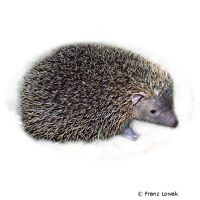Lesser Hedgehog Tenrec (Echinops telfairi)
| Lesser Hedgehog Tenrec Echinops telfairi | |
|---|---|
| Name | Lesser Hedgehog Tenrec |
| Name Lat. | Echinops telfairi |
| Family | Tenrecs |
| Family lat. | Tenrecidae |
| Order | Tenrecs & Golden Moles |
| Order lat. | Afrosoricida |
| Origin | Madagascar |
| Climate | Tropical |
| Habitat | Dry forest |
| Diet | Insects |
| Behavior | Nocturnal; ♂ territorial |
| Keeping | Individual, pair, harem |
| Care Level | Moderate |
| Life Span | 4-8 years |
| Protection | No |
| Metric Units | |
| Size | 13-18 cm |
| Temperature | 25-28 °C |
| Housing | A: 1 m² / H: 0,6-1 m |
| US Units | |
| Size | 5.1"-7.1" |
| Temperature | 77-82 °F |
| Housing | 10 ft² / 30" hight |
Distribution and habitat
The predominantly nocturnal Lesser Hedgehog Anrec inhabits dry forest areas in the south and southwest of Madagascar. They are mainly ground dwellers that can climb very well. During the day they sleep hidden in tree hollows, hollow branches and self-dug holes in the ground.
Maintenance
Minimum dimensions for the enclosure:
| 1-2 animals | area: 1 m² | height: 1 m |
A terrarium placed in a bright (no direct sunlight), draught-free and quiet place is recommended, with ventilation openings at the sides, and it must not be tightly closed at the top.
The enclosure should be diversely structured with stones, roots, branches and wooden bridges, and provide hiding and shelter opportunities (wooden sleeping houses, tubes, clay caves, etc.). They need food and drinking containers (drinking bottles), a sand bath (chinchilla sand), nest building material (hay, straw, etc.) and a deep substrate for digging. Commercially available small animal litter, terrarium humus or a sand-peat mixture covered with some bark mulch, dry leaves, hay and straw is suitable as a substrate. The bedding depth should be at least 15 cm, better 20 cm.
| Temperature day: 25-28 °C | Temperature night: 22-24 °C | Temperature local: 35 °C |
Light sources that also produce the necessary heat are ideal. Attention should be paid to their natural day-night rhythm.
Diet
They feed mainly on insects and small vertebrates as well as fruit. The species-appropriate diet consists of live insects such as crickets, cockroaches, crickets, grasshoppers, earthworms, zophobas and mealybug larvae, supplemented with small amounts of fruit (bananas, apples, melons, etc.) and cooked rice. The quality of the feed can be enhanced by feeding overripe fruit and honey water. It is important to regularly add minerals and vitamins (e.g. by dusting the feed animals). Often the change to commercial ready-made food for insectivores, supplemented with premium cat food, is successful. Water must always be available in hanging bottles or in stable, open containers and, like food, must be offered fresh daily
A varied diet promotes health and prevents deficiency symptoms.
Behaviour and compatibility
They should be kept in pairs. If there is one male with several females (harem) or only females, group keeping is also possible. Males behave aggressively among themselves. At the first sign of incompatibility, the animals should be separated immediately.
Reproduction and breeding
The males are clearly recognizable by the bulge-like eye ring
Mating occurs shortly after the end of the resting period. During the mating season, males in heat run a white, viscous secretion from the eye glands down the sides of their heads, which they rub on themselves and the females. The gestation period is 62-65 days. A litter consists of 1-10 young, which are born blind and naked. After 10 days the eyes open. They take their first solid food after 17 days, are independent after 33 days and sexually mature after the resting period.
Important
A sunny spot irradiated with a heat lamp (spot) is also gladly visited during the day. By installing a moonlight lamp they can also be observed at night.
It has proven to cover a part of the enclosure with litter and the other part with terrarium humus or a sand-peat mixture for digging
During their 3-5 month dormancy period, they consume little food and sleep most of the time. Room temperature should be reduced to 18-20 °C during this time. Since they can only imperfectly regulate their body heat, similar to reptiles, the ambient temperature must never be below 15 °C, otherwise they will fall into a cold torpor
Lighting and heat radiators must be placed in such a way as to prevent injury to the animals. Care must be taken to ensure thorough hygiene, especially at the fixed defecation sites, and contamination must be removed regularly
Further literature can be found in your pet store.
References
Text: petdata; Image: Franz Lowak
Source: W. PUSCHMANN, D. ZSCHEILE, K. ZSCHEILE (2009): Zootierhaltung - Tiere in menschlicher Obhut: Säugetiere, Harri Deutsch Verlag; BMEL (2014): Gutachten über Mindestanforderungen an die Haltung von Säugetieren
- Gemäß § 21 Abs. 5 Tierschutzgesetz idgF
